I spent what felt like a lot of time this summer in online workshops about how to teach online. I learned a lot of things — both by positive and negative association! — that will help me make my fall courses have better online content. Here are 5 big things I have in mind.
- Community of Inquiry Framework in online course design
- Bloom’s Taxonomy and Synchrony
- Same Goals, different modalities
- Variety in instructional modes
- Sit in an online course yourself
1. Community of Inquiry Framework and Supporting Discourse
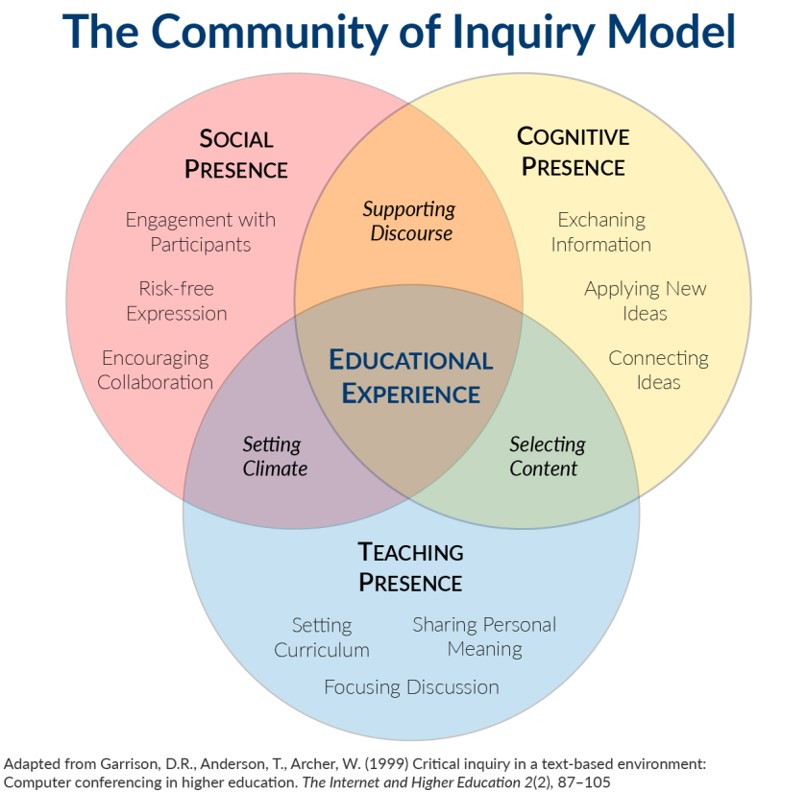
Like a lot of instructors at K, I’ve been thinking about how to foster community and support discourse among students in my classes. I’ve found myself stuck on that question and honestly discouraged by what felt like a lot of disconnected student experiences in my spring class. I gained some insight during an online session this summer centered on the Community of Inquiry Framework. In particular, my breakthrough moment came from looking at the pair-wise regions of intersection between the “Presences” — Teaching, Cognitive, and Social:
- Selecting Content
- Supporting Discourse
- Setting Climate
In the spring I gave a lot of thought to Selecting Content, and in struggling with ways to Supporting Discourse, I hadn’t fully considered the role of my teaching presence in Setting Climate. As an example, is his piece at the TLC Summer Teaching Development site, David Rhoa talks about how he noticed that students, if left to make that decision on their own, would often turn off their web cameras during synchronous video group meetings and by doing so be effectively absent from the discussion. He says if he had to do it again, he would set the expectation that students take part fully by keeping their cameras on. That’s Climate Setting! Now that we have some experience about how things can tend to happen, we are in a better place to set climate from the start to support discourse.
2. Bloom’s Taxonomy and Synchrony
Synchronous or Asynchronous? That’s a question I’ve spent a lot of discussion time on, often framed by various concerns that don’t pertain directly to teaching and learning: Students scattered across many time zones and other scheduling difficulties, technical challenges of large live video meetings, technical challenges of producing compelling video content, etc.
I had a pleasant aha moment last week when a participant in a big teaching seminar mentioned this paper in passing. The figure below is modified from that paper. The idea that grabbed me was that in organizing the kinds of learning I want students to achieve using Bloom’s Taxonomy, the timeline of learning activities seemed to fit very neatly:

At the base of the pyramid, it seems clear to me that students read, hear, remember and understand concepts at highly individual rates. Those activities are perfectly suited for outside of class reading assignments, pre-discussion activities, and my recorded video lectures — all things that students can do at their own speed and in their own time.
The middle layers of the pyramid are better suited for real-time interactions: Discussions with and between students that suggest and interrogate connections and contexts for ideas.
Finally, the tip of the pyramid takes repeated concerted attempts and lots of time — more than can be sustained in a Teams meeting. That’s where asynchronous delivery returns.
I’ve heard Josh Moon say many times that real-time interaction with students should be spent checking in and having conversations. One-way communication of content is best done asynchronously.
3. Same Goals, Different Modalities
There’s a lot to be said for designing an online course using Backward Design Principles. Sometimes though I find myself thinking backwards in a bad way: I sometimes look at what a technology platform is capable of doing and then try to build a teaching and learning activity with that as the basis. I sometimes forget that effective teaching and learning activities aren’t good only because they’re in person and face to face — that just happens to be the only modality I was really fluent in before Covid 19.
This idea — adapting existing active learning practices to online delivery modes — is at the heart of this handy table which lists teaching goals, traditional classroom active learning strategies and then suggests adaptations to online asynchronous, synchronous virtual online, and physically distanced face-to-face environments. I’ve excerpted a few rows of the table below:
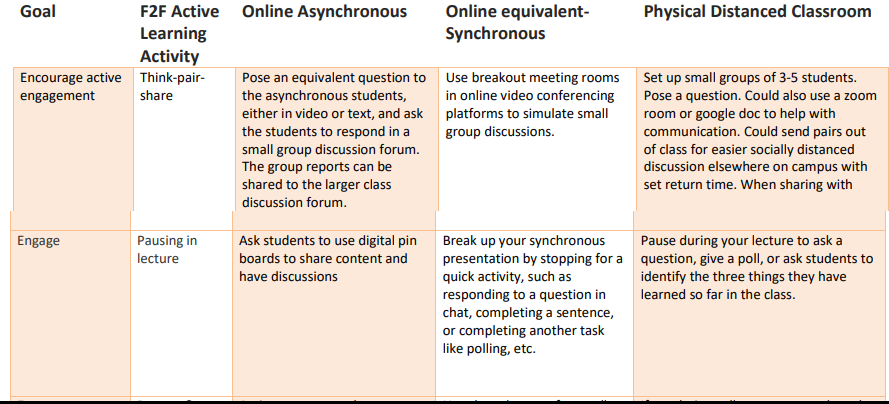
4. Include a Variety of Practices
A piece in the July 8 issue of Inside Higher Ed discusses results of two nation-wide surveys — one of college and university students and another for instructors. The former study identifies eight effective online teaching practices and reports data that seems to make a strong connection between student satisfaction with the course and the number of these practices incorporated. In his piece in the TLC Summer Teaching Development collection, Jeff Bartz looks back at his experience online in the spring through this framework.
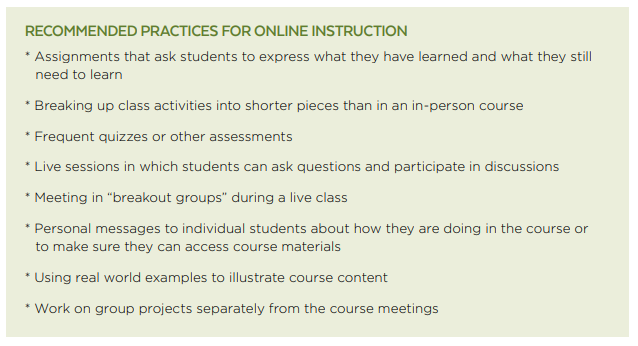
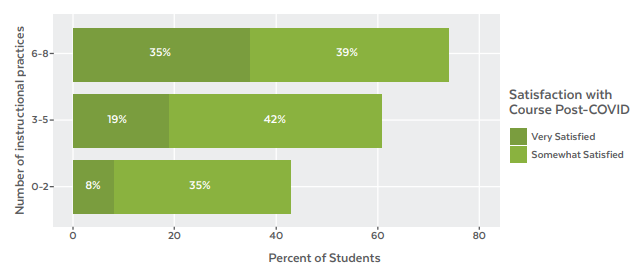
5. Try it yourself
I don’t really think of myself as a person with a bad attitude. That changed this summer. To prepare better for my work with TLC on the Summer Teaching Development resource, I registered for a number of multi-day online seminars for college teachers in the emerging world of online instructors.

I was already starting to feel a skin-crawling discontent by the time I logged in at the website for the first seminar! Before I even knew my registration was successful, my email inbox began rapidly filling with dozens of “get to know me” emails from the other participants: “Hi, I’m Matt from Plynthville College, Looking forward to the seminar!” Upon signing in, I learned that the first assignment of all participants was to type a message board introduction myself and comment on several others: “Nice to meet you Matt. I’ve heard great things about Plynthville.”

Over the following few days, I learned that it is really hard to sit in front of the screen and stay connected with my 30 classmates during a 90 minute video lecture. I learned that “enter your response in the chat” in a group that size results in a rapidly scrolling stream of consciousness with only the first and last entries, or those that already contain the vocabulary we’re trying to learn, gaining the attention of the instructor. I learned that the “raise my hand” feature works just as well or poorly as in any other large lecture: unless carefully managed, the same person raises their hand and talks repeatedly, day after day.
I learned from that experience the powerful lesson that there are lots of online teaching practices that I don’t want to use in my own course! As they say “experience is the best teacher.” But as a person who is really curious about how effective teaching works, I think I discovered how to do some of those things better. Try it. What you don’t find helpful might be the most useful thing for you to learn.

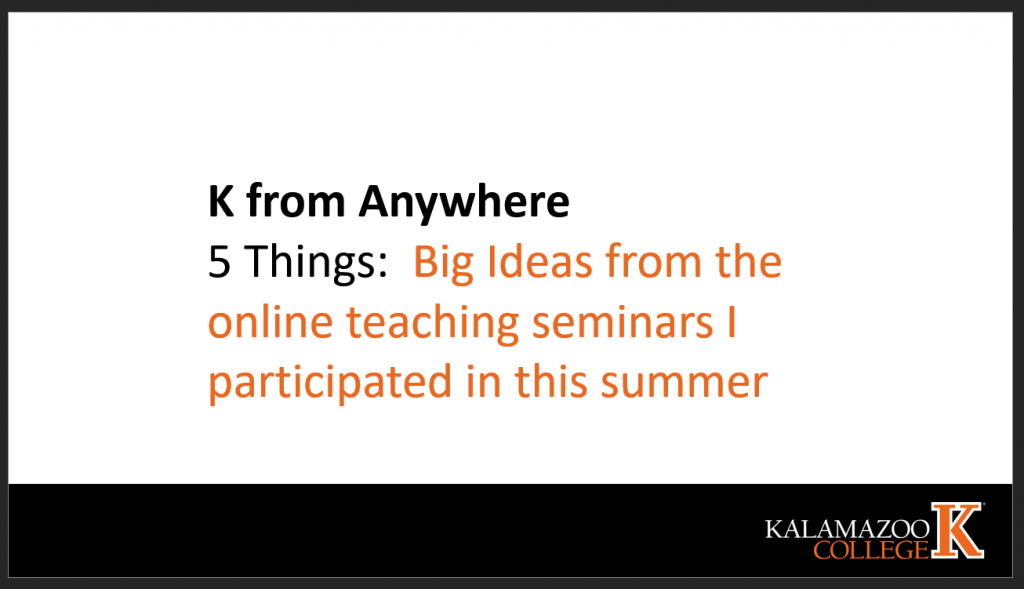
This is so helpful, Rick! I love the explanation community of inquiry framework and Bloom’s Taxonomy. Some of this discussion could be useful to students, as they think about their own engagement with Communities of Inquiry and Bloom’s. Do we dare think about developing a mini-orientation/webinar for students about how to take advantage of online learning? Preferably developed with student collaborators… DSAs? KCCSR? Thank you!
Dear Rick,
Thanks for developing this site for us. What I particularly found useful was your explanation of Bloom’s Taxonomy in the context of synchronous and asynchronous activities in class. Thanks for that!
This was great Rick, thank you! I appreciate the succinct overview, with links to more detail if desired!